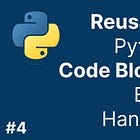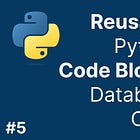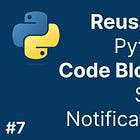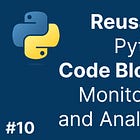Reusable Python Code Modules for Python for Super Fast API Development - Part 1
An Overview of Modules to Create for Yourself
Creating reusable code modules in Python is essential for building maintainable and scalable back-end applications. This series of blog posts meticulously covers each of the following code blocks in detail, including alternative libraries and options for their implementation.
Python is a versatile back-end programming language used for creating server-side applications on the Internet and mobile devices. As applications have evolved in complexity over the last two decades, user demands have made it crucial to thoroughly assess the architectural design of these applications from various perspectives. Ensuring effective request validation is key to maintaining data integrity and security. Implementing robust authentication and authorization is vital for protecting user data and managing access control. Proper error handling enhances user experience and facilitates debugging. Efficient database clients are necessary for managing data storage and retrieval.
All code blocks and more are commonly found in apps worldwide, which is why we evaluate modern apps through the lens of the code blocks defined below. Together, they form a rich application experience for your users. It is recommended to approach the implementation of modern apps from this perspective, utilizing code blocks as modules that can be plug-and-play.
Code Blocks
Introduction
Request Validation
Authentication and Authorization
Error Handling
Database Client
Email Notifications
Slack Notifications
SMS Notifications
Logging
Monitoring and Analytics
Pagination
Data Transformation and Formatting
Versioning
Middleware Management
2. Request Validation
Objective
Schema validation can be achieved using libraries like Pydantic or Marshmallow
These libraries ensure that all incoming data is correctly structured and secure
Implementing request validation in Flask or Django can automatically handle incoming data and provide detailed error messages
Key Concepts
Schema validation
Middleware integration
Validation libraries
3. Authentication and Authorization
Objective
JWT or OAuth 2.0 can be used for secure authentication in Python frameworks
Role-based access control (RBAC) helps manage user permissions effectively
Third-party authentication providers enhance security and flexibility in your applications
Key Concepts
Token-based authentication
Role-based access control
Middleware protection
4. Error Handling
Objective
Global error handlers in Flask or Django manage exceptions consistently
Custom error classes standardize error responses across the application
Logging with Python’s built-in logging module or external libraries like Loguru improves debugging and maintains reliability
Key Concepts
Custom error classes
Centralized error handling
Error logging
5. Database Client
Objective
ORM libraries such as SQLAlchemy or Django ORM facilitate efficient database interaction
Connection pooling improves performance by managing database connections effectively.
Database migrations and schema changes are handled seamlessly with tools like Alembic or Django migrations
Key Concepts
Connection management
Query builders
ORM/ODM integration
6. Notifications - Email
Objective
Libraries like smtplib or services like SendGrid can be used to send transactional emails
Email templates integrated with Jinja2 provide dynamic content
Configuring SMTP settings ensures reliable email delivery and enhances user communication
Key Concepts
SMTP configuration
Email templates
Send email function
7. Notifications - Slack
Objective
Real-time notifications can be sent to Slack using libraries like Slack SDK for Python
Webhooks automate alerts, keeping your team informed about application events and critical updates
Custom integrations enhance communication workflows within your application
Key Concepts
Webhook integration
Message formatting
Error handling
8. Notifications - SMS
Objective
Services like Twilio or Nexmo provide APIs for sending SMS notifications
These services enable transactional messages and effective management of delivery statuses
Implementing SMS notifications ensures timely communication with users on their mobile devices
Key Concepts
SNS configuration
Topic management
Publishing messages
9. Logging
Objective
Comprehensive logging is achieved using Python’s logging module or external libraries like Loguru
Configuring log levels, handlers, and formatters optimizes log management
Log rotation and archival strategies maintain system performance and storage efficiency
Key Concepts
Log levels
Centralized logging
Log rotation
10. Monitoring and Analytics
Objective
Monitoring tools like Prometheus and Grafana track application performance and user behavior
Integrating analytics platforms helps maintain system health and gain insights into key metrics
Custom dashboards and alerts monitor critical aspects of your application.
Key Concepts
Metrics collection
Dashboard creation
Alerting
11. Pagination
Objective
Efficient pagination can be implemented using Flask-Paginate or Django’s built-in pagination utilities
Creating responsive APIs that handle large datasets improves user experience
Strategies for handling large datasets ensure smooth performance and usability
Key Concepts
Offset and limit
Page and size
Links for navigation
12. Data Transformation and Formatting
Objective
Libraries like Pandas or NumPy transform and format data consistently in Python applications
Ensuring data integrity and readability makes your code more maintainable
Key Concepts
Data normalization
Data serialization
Format conversion
13. Versioning
Objective
API versioning strategies maintain backward compatibility
Tools like Flask-RESTPlus or Django Rest Framework provide mechanisms to version endpoints effectively
Handling deprecated features without disrupting users ensures a smooth transition
Key Concepts
URL versioning
Header versioning
Code structure
14. Middleware Management
Objective
Middleware patterns in Flask or Django manage request and response processing efficiently
Reusable middleware functions for tasks like authentication, logging, and error handling streamline your application’s architecture
Proper middleware management enhances the modularity and maintainability of your code
Key Concepts
Middleware chaining
Custom middleware
Middleware for different routes















